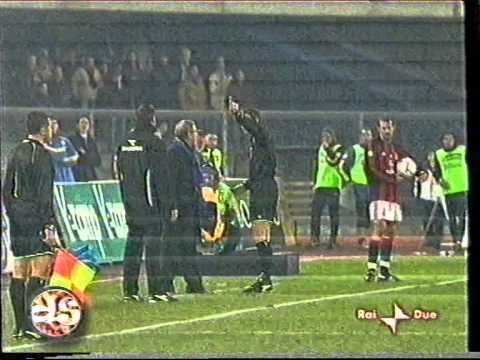Season 2003–04 UEFA Cup ParmaLazioUdinese Champion A.C. Milan Goals scored 811 | Champions Milan17th title Dates 30 Aug 2003 – 16 May 2004 Matches played 306 | |
 | ||
Champions League MilanRomaJuventusInternazionale Biggest home win Internazionale 6–0 Reggina(22 November 2003)Roma 6–0 Siena(22 February 2004) Similar | ||
The 2003–04 season in Italian Serie A football contained 18 teams for the 16th and last time from the 1988–89 season. With the bottom three being relegated, the 15th placed side would face the sixth-highest team from Serie B, with the winner playing in the Serie A in the subsequent 2004–05 season.
Contents
As usual, the top two teams would progress directly to the UEFA Champions League group stage, while third and fourth place would have to begin in the third qualifying round. The UEFA Cup places would be awarded to fifth and sixth place, and the winners of the Coppa Italia.
A.C. Milan won their 17th scudetto; Roma impressed and were pushing for the title until the last few weeks of the season; Internazionale only made it to the Champions League ahead of Parma and Lazio on the last day thanks to Adriano, who had been signed from Parma earlier in the season; Lazio won the Coppa Italia against Juventus, handing Udinese the UEFA Cup spot; Ancona were relegated with only two wins, the joint lowest tally ever (Brescia's 12 points in 1994–95 Serie A is still the lowest ever); Empoli and Modena were also relegated; Perugia lost their play-off with Fiorentina, who returned to Serie A after a two-year absence.
Ukrainian forward Andriy Shevchenko of Milan was the top scorer, with 24 goals. The 2003–04 league was the last professional season in the career of former European Footballer of the Year and Italian international Roberto Baggio, who finished among the tournament's top ten scorers with 12 goals, and among the all-time top five scorers in Serie A, with 205 career goals. It was also the last Serie A season for Baggio's former teammate Giuseppe Signori, who then moved to the Superleague Greece. Signori ended his career in Italy as the seventh highest scorer ever in Serie A.
Rule changes
Unlike La Liga, which imposed a quota on the number of non-EU players on each club, Serie A clubs could sign as many non-EU players as available on domestic transfer. But for the 2003–04 season a quota was imposed on each of the clubs limiting the number of non-EU, non-EFTA and non-Swiss players who may be signed from abroad each season, following provisional measures introduced in the 2002–03 season, which allowed Serie A & B clubs to sign only one non-EU player in the 2002 summer transfer window.
Managerial changes
League table
Source: Almanacco Illustrato del Calcio - La Storia 1898-2004, Panini Edizioni, Modena, September 2005
Rules for classification: 1) points; 2) head-to-head points; 3) head-to-head goal difference; 4) head-to-head goals scored; 5) goal difference; 6) number of goals scored
1 Udinese gained entry to the 2004–05 UEFA Cup as Coppa Italia finalists Lazio and Juventus qualified for the 2004–05 UEFA Cup and the 2004–05 UEFA Champions League through league position, respectively.
(C) = Champion; (R) = Relegated; (P) = Promoted; (E) = Eliminated; (O) = Play-off winner; (A) = Advances to a further round.
Only applicable when the season is not finished:
(Q) = Qualified to the phase of tournament indicated; (TQ) = Qualified to tournament, but not yet to the particular phase indicated; (RQ) = Qualified to the relegation tournament indicated; (DQ) = Disqualified from tournament.
Head-to-Head: used when head-to-head record is used to rank tied teams.
Results
Source: lega-calcio.it (Italian)
1 ^ The home team is listed in the left-hand column.
Colours: Blue = home team win; Yellow = draw; Red = away team win.
For coming matches, an a indicates there is an article about the match.
Serie A qualification
Perugia had to play a qualification match with 6th-placed team of Serie B, Fiorentina.
A.C. Perugia relegated to Serie B, while ACF Fiorentina was promoted to Serie A.
